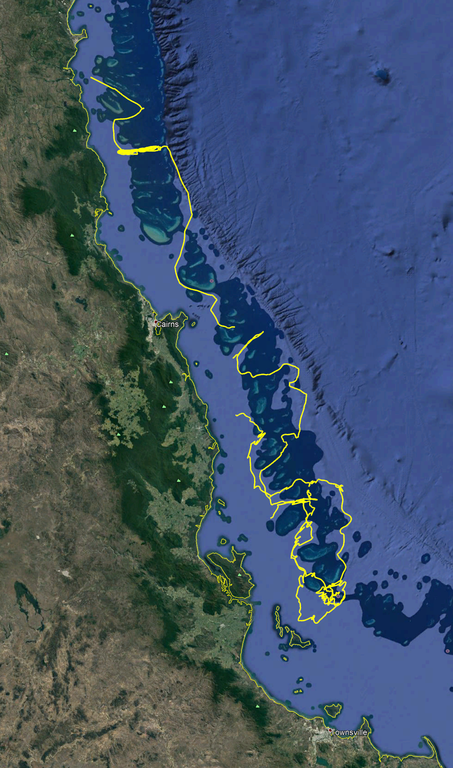From mid-November 2019 to late March 2020, IMOS ocean gliders spent 85 days at sea in the central and northern Great Barrier Reef (GBR), traveling a total of 1800 km between Cooktown and Townsville.
These gliders included routine IMOS deployments in the GBR as well as an additional deployment as part of the IMOS Event Based Sampling sub-Facility.
The ocean gliders made ~20,000 full-depth ocean profiles consisting of 3.5 million individual observations of temperature, salinity, oxygen, underwater light, chlorophyll, backscatter and CDOM. The data were immediately available to researchers as they were collected via near-real-time data delivery and following QA/QC processes the entire dataset is now publicly available via AODN.
Routine monitoring of ocean temperatures is generally undertaken using satellites that only sample the top few centimetres of the ocean. In contrast, ocean gliders sample the whole water column proving data on the sub-surface ocean structure. The IMOS Event Based Sampling sub-Facility was established to sample the subsurface structure during marine heatwaves using ocean gliders.
To our knowledge this is the most comprehensive in-water dataset collected during a coral bleaching event anywhere in the world. It provides a remarkable opportunity to examine closely the ocean weather associated with mass coral stress and bleaching/recovery. This dataset is particularly valuable because it can be placed in the climatological context of previous ocean glider missions undertaken over the past five summers on the Great Barrier Reef, as well as decades of long-term in-water fixed site monitoring by the Australian Institute of Marine Science (AIMS) at a number of locations.
In early summer (November 2019), the Great Barrier Reef lagoon water, in the vicinity of the glider deployment was vertically mixed (see Figure 2 at right), as would be expected at that time of year. The water column was warming at a typical rate close to climatology (~1 degC every 4 weeks) due to solar heating. The mean temperatures were well below climatology. The water column average in the glider data correlated very well with data from the AIMS weather station at nearby Agincourt Reef for the entire mission, which is what would be expected of a fully-mixed water column.
In late January 2020, the glider was redeployed following a period of calm weather (low-wind or “doldrum” days). At this stage of the summer, various models and products based on remote sensing were not predicting that ocean conditions would become sufficiently warm for an extended period to cause coral bleaching. However, the glider was reporting data consistent with a reduction in vertical mixing due to low winds. The vertical stratification observed in late January was an indication that the processes that lead to the accumulation of heat in the upper water column were in place. The heat was contained in the upper 20 m of the water column, whilst deeper waters (20 – 50 m depth) were up to 4oC cooler.
During February 2020, the AIMS weather station data from nearby Agincourt Reef recorded the lowest monthly average wind speeds since records began in 2014 (The only other similarly low-wind summer was 2017, which was also a bleaching year). By mid-February 2020, although models and remote sensing were still not sounding the alarm, the vertical stratification observed by the glider was intensifying and persistent (see Figure 2 at right). For more than six weeks, there was a marked difference in the water temperature above and below ~20 m depth. The average water column temperature from 0 – 50 m at this time was similar, if not a little cooler, than similar measurements taken in 2019 and 2018 (non-bleaching years).
In mid-March 2020, the glider measured a return to “normal” fully mixed water column conditions coincident with the arrival of the seasonal southeast trade winds (see Figure 2 at right). These glider observations provide compelling evidence that the 2020 coral bleaching event on the GBR was exacerbated by reduction in vertical mixing processes, in particular, wind mixing that would otherwise have distributed heat energy through the water column – as we observed during glider missions during the non-bleaching years of 2018 and 2019.
Instead, in 2020 each day of low winds and reduced mixing accumulated heat in the surface layer, increasing temperatures in the upper ~20 m. This insight – only available thanks to IMOS’ long term in-water data collection capabilities – leads to the question of whether interventions that increased vertical mixing could alleviate coral temperature stress during calm weather conditions, even at small scales.
The extensive datasets collected during these and other GBR ocean glider missions are being used by a range of science solution agencies, for example the Reef and Rainforest Research Centre (RRRC) in Cairns, to increase their understanding of fine-scale oceanography relevant to coral bleaching events, and inform potential interventions that could improve outcomes at the scale of a reef tourism site.
Dr Suzanne Long from the RRRC said that the data delivered by IMOS ocean gliders is invaluable. “Previously, because of over-reliance on remotely-sensed satellite sea surface temperature data, there was this misapprehension that during bleaching events, the GBR water column was uniformly hot,” she said. “Now, thanks to the in-situ data collected by IMOS, we know that’s definitely not the case. And this insight is powerful. Because it shifts the problem of reducing coral stress despite climate change from the ‘impossible’ basket, to ‘hey, actually there could be something we could try here.’”
Written by Chari Pattiaratchi (UWA), Dennis Stanley (UWA) and Suzanne Long (Reef & Rainforest Research Centre)
